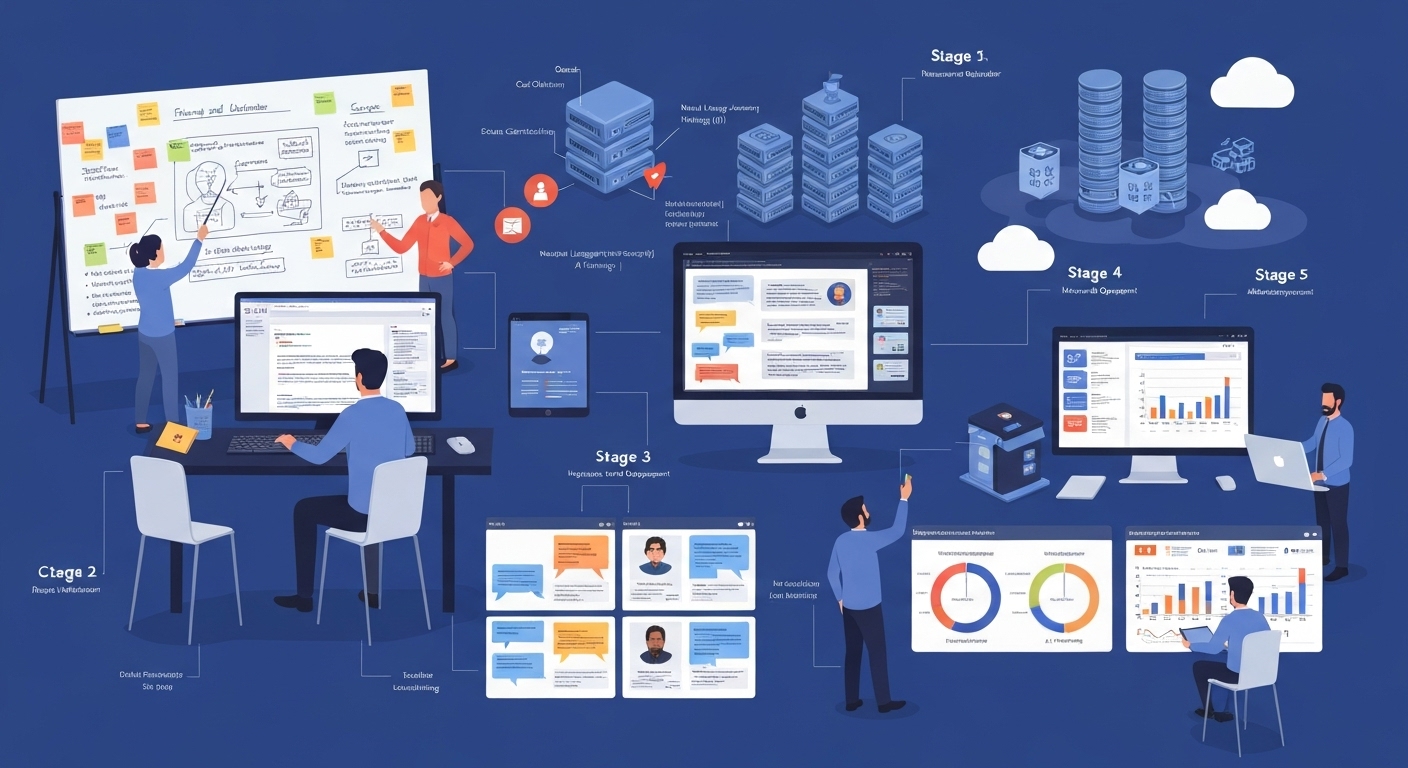Revolutionize Customer Service with AI – Powered Chatbots
AI-powered chatbots for customer support are rapidly transforming how businesses interact with their customers. These intelligent virtual assistants offer a scalable and efficient solution to common customer service challenges, providing instant support, personalized experiences, and valuable data insights.

The Rise of AI Chatbots in Customer Service
The increasing demand for instant gratification and 24/7 availability has made AI chatbots an indispensable tool for modern businesses. By leveraging natural language processing (NLP) and machine learning, these chatbots can understand and respond to customer inquiries in a human-like manner, resolving issues quickly and efficiently.
Key Benefits of Implementing AI Chatbots
- 24/7 Availability: Provide round-the-clock support, ensuring customers can get help whenever they need it.
- Reduced Operational Costs: Automate routine tasks and reduce the workload on human agents, leading to significant cost savings.
- Improved Customer Satisfaction: Offer instant responses and personalized solutions, enhancing the overall customer experience.
- Scalability: Easily handle a large volume of inquiries without compromising service quality.
- Data-Driven Insights: Collect valuable data on customer interactions, providing insights into customer needs and preferences.

Understanding Natural Language Processing (NLP) in Chatbots
Natural Language Processing (NLP) is the backbone of AI-powered chatbots, enabling them to understand and interpret human language. NLP algorithms analyze the intent behind customer inquiries, allowing the chatbot to provide relevant and accurate responses.
How NLP Powers Conversational AI
NLP enables chatbots to:
- Understand Intent: Determine the purpose behind a customer’s question or request.
- Extract Key Information: Identify relevant details from the customer’s message.
- Generate Human-Like Responses: Craft responses that are natural, engaging, and informative.
- Handle Ambiguity: Deal with vague or unclear language by asking clarifying questions.
Implementing AI Chatbots for Customer Service
Successful chatbot implementation requires careful planning and execution. Businesses need to define their goals, select the right chatbot platform, and train the chatbot to handle common customer inquiries effectively. USA.gov provides resources on federal regulations that can indirectly impact chatbot deployment, particularly concerning data privacy.
Steps to Successful Chatbot Implementation
- Define Clear Goals: Identify the specific objectives you want to achieve with your chatbot, such as reducing support tickets or increasing customer engagement.
- Choose the Right Platform: Select a chatbot platform that aligns with your business needs and technical capabilities.
- Train Your Chatbot: Provide the chatbot with a comprehensive knowledge base and train it to handle a wide range of customer inquiries.
- Integrate with Existing Systems: Integrate the chatbot with your CRM, help desk, and other relevant systems to ensure seamless data flow.
- Monitor and Optimize: Continuously monitor the chatbot’s performance and make adjustments to improve its accuracy and effectiveness.

Choosing the Right Chatbot Platform
Several chatbot platforms are available, each with its strengths and weaknesses. Businesses should carefully evaluate their options based on factors such as cost, features, ease of use, and integration capabilities. Consider factors like pre-built integrations, customization options, and pricing models.
Key Considerations When Selecting a Platform
- Integration Capabilities: Does the platform integrate seamlessly with your existing systems?
- Customization Options: Can you customize the chatbot’s appearance and functionality to match your brand?
- Scalability: Can the platform handle a large volume of inquiries without compromising performance?
- Pricing: Does the platform offer a pricing model that aligns with your budget?
Best Practices for AI Chatbot Customer Service
To maximize the benefits of AI-powered chatbots, businesses should follow best practices for chatbot design, training, and maintenance. This includes providing clear and concise responses, offering personalized recommendations, and continuously monitoring and optimizing chatbot performance.
Tips for Optimizing Chatbot Performance
- Provide Clear and Concise Responses: Ensure the chatbot’s responses are easy to understand and directly address the customer’s inquiry.
- Offer Personalized Recommendations: Tailor the chatbot’s recommendations to the customer’s individual needs and preferences.
- Use a Conversational Tone: Train the chatbot to communicate in a natural and engaging manner.
- Monitor Customer Feedback: Pay attention to customer feedback and use it to improve the chatbot’s performance.
- Regularly Update the Knowledge Base: Keep the chatbot’s knowledge base up-to-date with the latest information and product updates.
The Future of AI in Customer Service
AI-powered chatbots are constantly evolving, with new advancements in NLP and machine learning paving the way for even more sophisticated and personalized customer service experiences. As AI technology continues to advance, we can expect to see chatbots become even more capable of understanding and responding to complex customer inquiries.
Emerging Trends in AI Chatbots
- Proactive Customer Service: Chatbots will proactively reach out to customers with relevant information and offers.
- Omnichannel Support: Chatbots will seamlessly integrate with various communication channels, providing a consistent customer experience across all touchpoints.
- Hyper-Personalization: Chatbots will leverage advanced data analytics to provide highly personalized recommendations and solutions.
- Emotional Intelligence: Chatbots will be able to detect and respond to customer emotions, creating more empathetic and engaging interactions.
AI-powered chatbots are transforming customer service. To learn more about how you can leverage this technology, visit flashs.cloud.
Measuring Chatbot ROI
Determining the return on investment (ROI) of AI chatbots involves analyzing metrics such as reduced operational costs, increased customer satisfaction scores, and improved sales conversion rates. Quantifying these benefits can justify the initial investment and highlight the long-term value of chatbot technology.

Key Metrics to Track Chatbot Performance
- Cost Savings: Calculate the reduction in operational costs due to automated support.
- Customer Satisfaction (CSAT) Score: Monitor customer satisfaction levels after chatbot interactions.
- Resolution Rate: Track the percentage of customer issues resolved by the chatbot without human intervention.
- Lead Generation: Measure the number of leads generated through chatbot conversations.
- Sales Conversion Rate: Analyze the increase in sales conversions attributable to chatbot support.
AI-powered chatbots for customer support are not just a trend; they are a fundamental shift in how businesses interact with their customers. By embracing this technology and implementing best practices, businesses can deliver exceptional customer experiences, reduce operational costs, and gain a competitive edge.
HOTLINE
+84372 005 899


